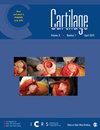针对骨关节炎中软骨生成诱导和软骨再生的多肽
IF 2.7
4区 医学
Q1 ORTHOPEDICS
引用次数: 0
摘要
研究对象骨关节炎(OA)是一种常见于老年人的广泛退行性关节疾病。目前,尚无改变病情的药物,而常用的传统药物也存在安全隐患。在本综述中,该领域的大部分研究都集中在软骨方面,旨在发现阻止软骨破坏或促进软骨修复的方法。本综述的重点是以肽为基础的分子,这些分子因能选择性地与生长因子细胞因子和软骨细胞外基质的成分结合而闻名。本综述概述了软骨诱导肽的设计、分子机制及其在软骨组织工程中的应用,并比较了它们在体外和体内软骨生成中的功效。结论本文将总结肽作为支架、功能分子或二者兼具的工程再生软骨的应用,并讨论肽的其他可能性。这篇综述文章概述了我们目前对用于治疗受 OA 影响的软骨的软骨诱导肽的理解,并探讨了用于再生的传递系统。这些进展有望加强甚至取代目前的治疗方法。本文章由计算机程序翻译,如有差异,请以英文原文为准。
Peptides for Targeting Chondrogenic Induction and Cartilage Regeneration in Osteoarthritis
ObjectsOsteoarthritis (OA) is a widespread degenerative joint condition commonly occurring in older adults. Currently, no disease-modifying drugs are available, and safety concerns associated with commonly used traditional medications have been identified. In this review, a significant portion of research in this field is concentrated on cartilage, aiming to discover methods to halt cartilage breakdown or facilitate cartilage repair.MethodsResearchers have mainly investigated the cartilage, seeking methods to promote its repair. This review focuses on peptide-based molecules known for their ability to selectively bind to growth factor cytokines and components of the cartilage extracellular matrix.ResultsChondroinductive peptides, synthetically producible, boast superior reproducibility, stability, modifiability, and yield efficiency over natural biomaterials. This review outlines a chondroinductive peptide design, molecular mechanisms, and their application in cartilage tissue engineering and also compares their efficacy in chondrogenesis in vitro and in vivo.ConclusionsIn this paper, we will summarize the application of peptides engineered to regenerate cartilage by acting as scaffolds, functional molecules, or both and discuss additional possibilities for peptides. This review article provides an overview of our current understanding of chondroinductive peptides for treating OA-affected cartilage and explores the delivery systems used for regeneration. These advancements may hold promise for enhancing or even replacing current treatment methodologies.
求助全文
通过发布文献求助,成功后即可免费获取论文全文。
去求助
来源期刊

CARTILAGE
ORTHOPEDICS-
CiteScore
6.90
自引率
7.10%
发文量
80
期刊介绍:
CARTILAGE publishes articles related to the musculoskeletal system with particular attention to cartilage repair, development, function, degeneration, transplantation, and rehabilitation. The journal is a forum for the exchange of ideas for the many types of researchers and clinicians involved in cartilage biology and repair. A primary objective of CARTILAGE is to foster the cross-fertilization of the findings between clinical and basic sciences throughout the various disciplines involved in cartilage repair.
The journal publishes full length original manuscripts on all types of cartilage including articular, nasal, auricular, tracheal/bronchial, and intervertebral disc fibrocartilage. Manuscripts on clinical and laboratory research are welcome. Review articles, editorials, and letters are also encouraged. The ICRS envisages CARTILAGE as a forum for the exchange of knowledge among clinicians, scientists, patients, and researchers.
The International Cartilage Repair Society (ICRS) is dedicated to promotion, encouragement, and distribution of fundamental and applied research of cartilage in order to permit a better knowledge of function and dysfunction of articular cartilage and its repair.
 求助内容:
求助内容: 应助结果提醒方式:
应助结果提醒方式:


